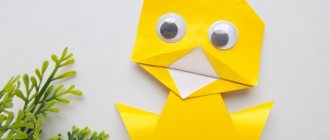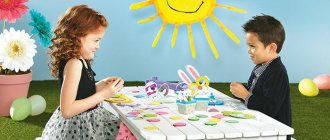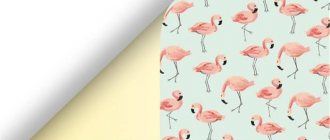Summary of GCD in the senior group. Topic: paper construction (origami) “Airplane”.
Summary of continuous educational activities in the senior group.
Subject:
designing an “Airplane” out of paper (origami).
Educator: Gavrilyuk Svetlana Vladimirovna
Program content:
To promote the accumulation in children of specific ideas about airplanes;
Refine and consolidate the ability to fold a sheet of paper in half, diagonally;
Teach children to work according to the model;
Strengthen children's knowledge about types of aircraft and their purpose;
Foster a sense of responsibility and collectivism.
Material and equipment:
illustrations of different types of aircraft; sheets of paper, aircraft manufacturing diagram, felt-tip pens.
I.part
Educator: Hello, guys. I am very glad to see you at the lesson for young modelers and designers. What we will construct today, you will find out by guessing the riddle: Who can tell me what kind of bird is rushing in the sky like the wind. White draws a trail behind him in the blue azure? And the pilot is driving it! - What is this? - … (Airplane)!
Educator: Guys, how can you figure out what the plane is for? (children's answers)
Educator: Guys, what types of aircraft do you know? (children's answers).
Educator: What are passenger planes for? (intended for transporting passengers and luggage).
Educator: What are cargo planes for? (intended for transporting various goods).
Educator: what is military aviation needed for? (designed to solve problems of a defensive and offensive nature).
Educator: Guys, how are airplanes used in agriculture? (application of mineral fertilizers, use of growth stimulants, pest and weed control, protection of crops from diseases, monitoring).
Educator: I suggest you and I go on a trip by plane.
Dynamic game "Airplane".
We get on the plane. (We squat).
Let's take off. (They start it up, get up, buzz-zhu.)
We are flying above the clouds. (Hands to the side).
We wave to dad, we wave to mom. (We wave with our left hand, we wave with our right hand).
We see how the river flows. (Show waves with hand).
We see a fisherman in the boat. (They show how a fisherman casts a fishing rod).
Watch out, mountain! (Lean to one side, then to the other).
It's time for us to land! (Sit down in their seats). Part II. Showing methods of action. Collaborative work between children and teacher.
Educator: Now we are leaving from the Kindergarten airport to the Konstruktorskoye airport, and this is where the second part of the flight training will take place.
Educator: I will teach you how to make paper airplanes. What do you think is the best paper to use?
Children: Thin and strong.
Educator: You are right. How do you think the paper should be folded to make the planes beautiful?
…
Target.
Give children an idea of airplanes, their types, and the dependence of their structure on their purpose; to summarize: all airplanes have wings, a cabin, a cockpit, a tail, and a landing gear; practice in designing aircraft according to a model, transforming a model according to certain conditions, in planar modeling using diagrams, in coming up with your own variants of buildings; develop the ability to outline the sequence of construction of the main parts, distinguish and name geometric shapes, reason, and draw independent conclusions.
…
Material.
Construction kits, scissors.
Progress
Offer the children the task that the Cube has prepared for them: cut out geometric shapes (Fig. 38 - 39) according to the markings.
Rice. 38
Rice.
39 Working with illustrations “Helicopter”, “Airplane”.
Invite the children to find a picture with a helicopter in the upper right corner (Fig. 40) and apply geometric shapes (Fig. 38) to the image so as to cover all the details of the picture.
Rice. 40
Work with the next illustration (Fig. 41) in the same way, but invite the children to superimpose the figures (Fig. 39) on their contour images.
Rice. 41
Tips for a teacher
As you work, ask the kids whose successes you don’t have a strong opinion about to name the geometric shapes they use. Remind children to put the shapes back in envelopes when finished. Rejoice at how many geometric shapes the kids have now. Carry out games and exercises on plane modeling more often.
Working with illustrations.
Select illustrations that depict various aircraft. Consider them with your children, analyze the structure of the aircraft, determine the functional purpose (passenger, sports, military). Give the guys a riddle:
White bird
It rushes across the sky,
Dancing in the clouds
But he doesn’t flap his wings.
(Airplane)
Game "Airport".
Before the lesson starts, build an airport building with the children on shifted tables. Leave space on the tables for the runway. Take a long plate, place a short one across it and say: “This is an airplane and a pilot.” Start imitating the flight of an airplane and the sound of the engine. Let the guys join the game. Then say: “The pilots are tired, the gas in the tanks is running out - we’ll fly to the airport.” Invite the children to arrange their planes on the tarmac.
Build 2-3 different planes. Determine with your children what parts can be used to construct the chassis, interior, cabin, and wings.
Invite the children to choose and build any plane. Encourage changes and additions to designs, building “your own way,” and the desire to build several models.
Upon completion of construction, analyze the resulting structures.
Organize a construction project using Lego constructors. Show the children several design options: let the children build according to your model or come up with their own airplanes.
Game "Construction".
Offer children small toys and organize games, for example, you can build minibuses, gas stations, kiosks; decorate the airport area with trees and flowers. Take an active part in children's construction and games.
Game tasks.
Construction of aircraft of different sizes and designs (for toys and any cargo) from various building materials and construction kits.
Construction on the themes: “Little people flew on airplanes to a fairyland,” “Parade of airplanes,” “Children’s playground with airplanes,” “Carousel with airplanes.”
Game "Let's go for a visit."
Invite the children to visit old acquaintances - the animals living on the first pages of the book (Fig. 2, 3, 4, 5, 7, 8, 9, 10). Let the children look at the geometric shapes that make up the images, varying in shape, size and color.
Tips for a teacher
Expand children's understanding of airplanes; look at illustrations and toys with them; show different construction options. Promote co-creation and mutual learning. Encourage children to make up stories about their designs.
Keyword
Circuit.
Airplane model with propeller
This is an ideal model for outdoor games with your baby. To work you will need a sheet of paper, scissors, a pencil and a pin with a bead at the end.
The sequence of actions is as follows:
- Roll a regular sheet lengthwise and fold the sides towards the center.
- Fold the resulting corners inward again.
- Fold the sides inward again and press the folds well.
- The propeller is made from a 6 cm square of paper. You need to draw it diagonally. Cut along these lines, moving 1 cm away from the center.
- Fold the propeller, directing the corners to the center alternately. Secure in the center with a needle. To prevent the craft from falling apart, you need to glue its parts.
Place the propeller at the tail of the plane, it is ready to fly up.
Boomerang plane
How to make an interesting airplane - a boomerang out of paper, step-by-step instructions:
- Fold a regular sheet in half twice and fold the corner.
- Fold one side of the rectangle to the middle.
- Then bend it inward to create a triangle.
- “Flatten” the resulting triangle, as done in the video.
- Turn the workpiece over and place a piece of the triangle inside.
- Fold the wide side of the workpiece towards the “pocket” on both sides.
- Lift the top of the “pocket” and roll it horizontally.
- Place the corner in the “pocket”. Do the same with the other side.
- Fold up the side of the large “pocket” on both sides.
- Unfold the craft and place its outer part inside.
- Turn the craft and bend its front part.
- Fold the craft in half.
- Create the fuselage: Fold the side down along the fold on both sides.
- Fold a small portion of the wing upward on both sides.
- Unbend the craft. Using your fingers, make a bend line on the front of the wings.
Playing with such a plane will be interesting and fun.
Very fast plane
How to create a model of a cool airplane that flies fast. This is a supersonic bomber and is very easy to make:
- Fold a regular sheet of paper in half lengthwise.
- Bend the side parts inward.
- Fold the paper inward along the dotted lines.
- Then fold along the axis, and the corners should be on the outside.
- Fold the wings of the bomber as shown in the diagram.
- The angle between the wing and the fuselage must be right.
- It turned out to be a cool supersonic airplane.
Cardboard airplane
You will need: colored cardboard, a simple pencil, scissors, an empty matchbox, a ruler, PVA glue.
Master Class
- Cut a strip of colored cardboard 21 cm long and 1.5 cm wide.
- Cut 2 identical strips of cardboard measuring 17x4 cm, then round the corners.
- Fold the long strip in half and glue it exactly in the center of the matchbox.
- Apply glue to the top and bottom of the box and immediately glue the wings.
- Cut out the remaining parts: 2 strips measuring 5x1.5 cm; propeller and chassis.
- Cut and round the corners of one of the strips.
- Glue 2 strips to form the tail of the plane.
- Glue the propeller and landing gear to the plane.
- An airplane made of cardboard and a matchbox is ready!
creative airplane
You will need: a large cardboard box, pieces of cardboard, a sharp knife, scissors, a ruler, a pencil, a plastic bottle, red spray paint, round foam rubber, tape, a black marker.
Master Class
Draw 2 rectangles on the surface of the box, then cut them.
Cut 2 rectangles in the same way on the other side of the box.
Cut 3 holes in the back of the box for the tail of the plane: one hole vertically in the center, and two horizontally on the sides.
Prepare cardboard rectangles and insert them into the tail holes.
Cut holes horizontally on the sides of the plane for the wings.
Prepare 2 cardboard rectangles and insert them into the side holes as wings.
Cut a circle from the foam rubber and attach it with tape to the airplane wing as landing gear. Attach the second circle to the other wing in the same way.
Draw 2 airplane controls on cardboard, decorate them with a marker and cut them out.
Tape the steering wheels to the boxes as shown in the image.
Make a screw from cardboard and a plastic bottle.
Cut a round hole at the front of the plane and attach the screw.
Disassemble the plane into parts.
Spray paint the plane and all its parts.
Wait for it to dry and assemble the plane.
The creative plane is ready! Children will really like this toy.
DIY PAPER AIRPLANE FOR CHILDREN
In fact, what we are doing today is origami. We will make a complex structure from a simple sheet of paper. So let’s bend it, fold it here, and in the end the plane will fly!
1. Place an A4 sheet of paper vertically in front of you. And bend the 2 side corners so that the sides meet exactly in the middle.
2. Bend the sheet along the bottom side of the resulting triangle.
3. We connect the upper side corners of the workpiece at the middle of the sheet so that a small triangle remains under the connection point, which we bent a little earlier.
4. We bend this triangle upward and press down the bent edges.
5. Turn the workpiece over and fold it in half. Connecting the sides.
6. Bend the wings in half so that the top side is level with the bottom of the workpiece.
Advice from the author of this design option is to launch the airplane easily, without effort or tension.
Then the structure will float for a long time, catching air currents with its wings.
A PAPER AIRPLANE FLYS FOR A VERY LONG TIME
In order for the plane to fly, you need not only to release it, giving it acceleration, but also to make a model that will be light, and at the same time, “weighted” in the body. This is exactly the model we will talk about now.
1. We start as usual: fold the sheet (A4) in half lengthwise.
2. We bend the corners to the middle line diagonally.
3. Once again, diagonally bend the sides to the middle line.
4. Fold the model along the middle line.
5. Bend the sides of the workpiece to the bottom line.
That's all. Such a simple model will fly great. She can handle even a little wind!
Children's plane
You will need: cocktail tube, colored paper, scissors, tape with a pattern.
Master Class
- Cut 2 strips of colored paper.
- Shorten one of the strips slightly.
- Connect the ends of each strip and secure with tape. You should have 2 circles.
- Attach the circles with tape on different sides of the cocktail straw as shown in the image.
- Send the structure into flight.
A children's airplane made from paper and a cocktail tube is ready!





